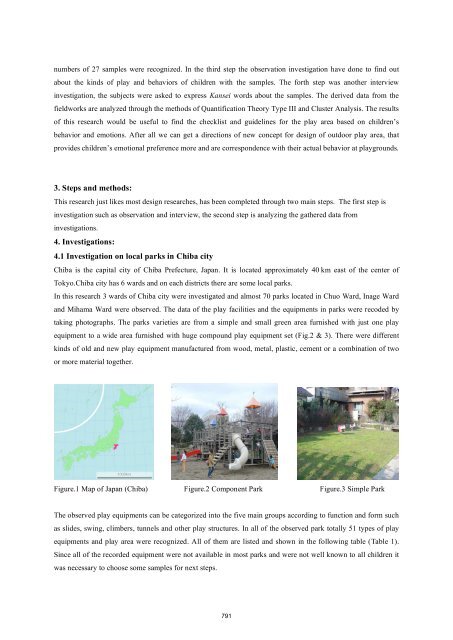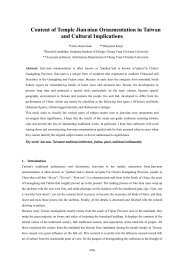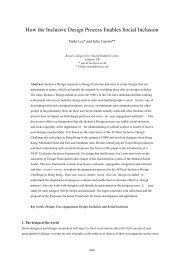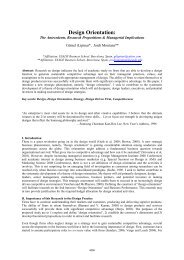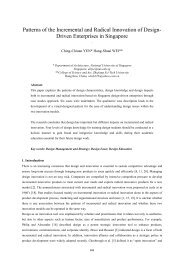Case study about a new design concept for public ... - iasdr 2009
Case study about a new design concept for public ... - iasdr 2009
Case study about a new design concept for public ... - iasdr 2009
Create successful ePaper yourself
Turn your PDF publications into a flip-book with our unique Google optimized e-Paper software.
numbers of 27 samples were recognized. In the third step the observation investigation have done to find out<br />
<strong>about</strong> the kinds of play and behaviors of children with the samples. The <strong>for</strong>th step was another interview<br />
investigation, the subjects were asked to express Kansei words <strong>about</strong> the samples. The derived data from the<br />
fieldworks are analyzed through the methods of Quantification Theory Type III and Cluster Analysis. The results<br />
of this research would be useful to find the checklist and guidelines <strong>for</strong> the play area based on children’s<br />
behavior and emotions. After all we can get a directions of <strong>new</strong> <strong>concept</strong> <strong>for</strong> <strong>design</strong> of outdoor play area, that<br />
provides children’s emotional preference more and are correspondence with their actual behavior at playgrounds.<br />
3. Steps and methods:<br />
This research just likes most <strong>design</strong> researches, has been completed through two main steps. The first step is<br />
investigation such as observation and interview, the second step is analyzing the gathered data from<br />
investigations.<br />
4. Investigations:<br />
4.1 Investigation on local parks in Chiba city<br />
Chiba is the capital city of Chiba Prefecture, Japan. It is located approximately 40 km east of the center of<br />
Tokyo.Chiba city has 6 wards and on each districts there are some local parks.<br />
In this research 3 wards of Chiba city were investigated and almost 70 parks located in Chuo Ward, Inage Ward<br />
and Mihama Ward were observed. The data of the play facilities and the equipments in parks were recoded by<br />
taking photographs. The parks varieties are from a simple and small green area furnished with just one play<br />
equipment to a wide area furnished with huge compound play equipment set (Fig.2 & 3). There were different<br />
kinds of old and <strong>new</strong> play equipment manufactured from wood, metal, plastic, cement or a combination of two<br />
or more material together.<br />
Figure.1 Map of Japan (Chiba) Figure.2 Component Park Figure.3 Simple Park<br />
The observed play equipments can be categorized into the five main groups according to function and <strong>for</strong>m such<br />
as slides, swing, climbers, tunnels and other play structures. In all of the observed park totally 51 types of play<br />
equipments and play area were recognized. All of them are listed and shown in the following table (Table 1).<br />
Since all of the recorded equipment were not available in most parks and were not well known to all children it<br />
was necessary to choose some samples <strong>for</strong> next steps.<br />
791


